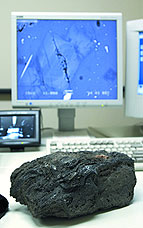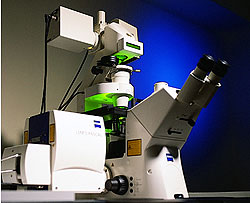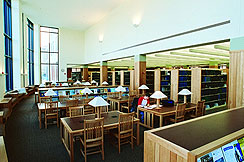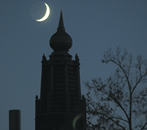| Physics
The Wright Laboratory of Physics forms the eastern leg of the
Science Center. The building's 60-year-old basement laboratory
complex was renovated in 1993, nearly three years before planning
for the center had even begun. In the intervening years, the
physics faculty snared grants to cram those labs with a new
generation of high-tech equipment.
In one of those basement labs, Assistant Professor
Stephen FitzGerald uses a four-year-old infrared spectrometer
to study Buckminster Fullerenes, a form of carbon with a molecular
shape. Fullerene molecules, or buckyballs as they are commonly
known, clump together in a closed, lattice-like structure that
can trap molecules of smaller elements such as hydrogen. FitzGerald's
research could help determine whether Fullerenes will work as
efficient gas-storage units in hydrogen-powered cars.
Meanwhile, Assistant Professor Yumi Ijiri is trying
to create a better computer hard drive. With the help of a $150,000
device called a vibrating sample magnetometer, which measures
the magnetic properties of materials, she is testing magnetized
iron compounds, hoping to find one that can hold more data than
the compounds used in today's hard drives.
The magnetometer--along with the physical layout
of the new building--has fostered a better connection between
the physics and chemistry departments, says Ijiri. The departments
are now physically linked and share three major pieces of equipment.
 Geology Geology
Volcanoes differ in the way they erupt and in the chemical makeup
of their debris. The College's new scanning electron microscope
allows Assistant Professor of Geology Jonathan Castro to examine
the fragments left by an erupted volcano (left), which could help
predict future volcanic activity and potentially save lives. The
microscope magnifies the fragments 100,000 times and provides a
chemical readout of the elements. With it, Castro is searching for
evidence that mountains in California's eastern Sierra Nevada range
have produced eruption columns, or plumes, that can shoot 40 miles
high and prove deadly when collapsing to the ground. He and other
researchers have found evidence of plume production within the last
500 years, information which could shape evacuation plans for the
region, which attracts hundreds of thousands of tourists and summer
residents each year.
 Neuroscience Neuroscience
Although we live in a three-dimensional world, old-fashioned
light microscopes provide only two-dimensional images. That
discrepancy disappeared for Oberlin neuroscientists when the
College installed a $225,000 confocal microscope (left) in a
specially designed room. The microscope sends an image to a
computer screen, offering Associate Professor Lynne Bianchi
a three-dimensional view of the tiny hairs that protrude from
cells that line the inner ear--a capability that helps her probe
why people lose their hearing.
With the College's old light microscope, Bianchi
couldn't make out how the cells lay in relation to one another,
but with the confocal, she can easily rotate her samples to
see how the cells are arranged. "It's a standard piece
of equipment for people doing cutting-edge research," Bianchi
says. "I'm doing here what I would be doing at a research
university. If Oberlin didn't have the facilities, I wouldn't
have been able to do this research, and I wouldn't have stayed."
 Science
Library and Commons Science
Library and Commons
Incorporating the collections of both the old library in Kettering
and the Physics Reading Room in Wright, the new Science Library
(left) can accommodate nearly 87,000 volumes, almost twice as many
as the old Kettering facility. The library features two group-study
rooms and a computer classroom for teaching students how to find,
evaluate, and use information, essential knowledge for today's research-driven
curriculum.
Extremely inviting with its Mission-style wooden
furniture and table lamps, the library is both utilitarian and
comfortable. A curving, two-story, glass exterior wall floods
the space with natural light, and cushioned window seats are
roomy enough for napping.
Though primarily a facility for science research,
the library is also part of the College's plan to encourage
science literacy in the next generation of graduates. The hope
is that the facilities will lure humanities students into the
building and entice them to linger, and then, perhaps, enroll
in some basic science courses.
Time will tell if the plan works, but anecdotal evidence
suggests non-scientists are flocking to the library and the commons,
an adjacent 4,000-square-foot lounge. The library's gate count on
the first day of final exams last May exceeded that of an entire
month at the old facility, says science librarian Alison Ricker.
So many non-scientists have been studying in the science library
that the reference desk now stocks a style guide for writing humanities
papers.
"I've seen Conservatory students reading
their musical scores in the science library," says Mehta,
the assistant professor of chemistry.
"In the old science library, people came in,
got what they needed, and left," says Ricker. "Students
found it intimidating. But they like being here."
 Bringing
the Sciences Together Bringing
the Sciences Together
When Norman Craig, Emeritus Biggs Professor of Chemistry, arrived
on campus as a freshman more than half a century ago, interdisciplinary
science majors were years in the future and the departments
were geographically separate. Chemistry resided in Severence,
physics in Wright, and zoology in a converted church. Botany
and geology operated from old houses.
When Craig retired in 2000, interdisciplinary
courses and majors were commonplace and construction had begun
on a Science Center with the promise of uniting most of the
science disciplines--old and new--in a single building. In fact,
the Science Center fulfills a vision that dates back to the
completion of Wright in 1942. The physics building was to have
anchored a unified science complex, but the other links were
never built.
Much has changed since then, but in an age
of interdisciplinary science, a unified facility makes more
sense now than ever before. It may have taken 60 years, but
Oberlin finally has a center for science.
Page 1
| 2 | 3
| 4 of A New Day for Science
|


